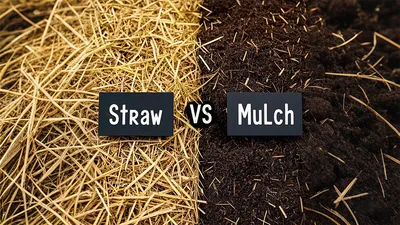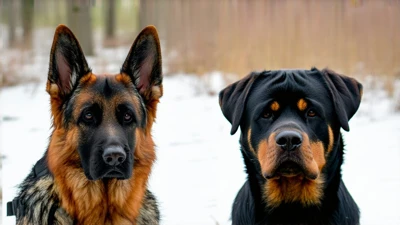
Comparison Table
| Comparison Factor | German Shepherd | Rottweiler | Notes |
|---|---|---|---|
| Primary Protective Instinct | High | High | Both breeds are protective by nature. German Shepherds, however, were bred for herding and guarding, giving them a small advantage in proactive protection. |
| Territorial Behavior | Very High | High | German Shepherds are highly territorial and consistently notify their owners of any intrusions. |
| Trainability | Excellent | Good | German Shepherds are ranked higher in obedience and are therefore easier to train for particular protective jobs. |
| Aggression Toward Strangers | Moderate | Higher | A Rottweiler's natural suspicion of strangers can lead to enhanced protective behavior. Socialization must be done with care. |
| Loyalty to Family | Extremely High | High | When German Shepherds bond closely with their families, their instinct to protect grows stronger. |
| Physical Strength | Strong | Very Strong | Rottweilers possess a thick and powerful build, making them highly effective for physical defense. |
| Bite Force (PSI) | 238 PSI | 328 PSI | When it comes to protection, Rottweilers' stronger bite can make them more effective. |
| Energy Levels | High | Moderate | German Shepherds maintain high energy levels during extended protective tasks. |
| Prey Drive | High | Moderate | Because of their high prey drive, German Shepherds are often more alert and ready to chase. |
| Socialization Needs | Requires Early Training | Requires Early Training | If trained properly, German Shepherds show greater adaptability to varied environments compared to others who also need socialization. |
| Historical Guard Roles | Military/Police Work | Livestock Guardian | In many countries, German Shepherds serve in professional protective roles. |
| Barking Frequency | Frequent | Moderate | To alert their owners, German Shepherds bark more frequently. They function as an early warning system. |
| Adaptability to Cold | Excellent (double coat) | Fair | Their heavy coat helps German Shepherds endure harsh outdoor conditions. |
| Health Lifespan | 9–13 years | 8–10 years | German Shepherds live longer on average. As a result, they give extended protection. |
| Common Health Issues | Hip Dysplasia, Degenerative Myelopathy | Hip Dysplasia, Heart Conditions | Rottweilers experience greater health risks that may reduce their reliability over time. |
| Size (Average Weight) | 50–90 lbs | 80–135 lbs | The larger size of Rottweilers can make intruders feel more intimidated. |
| Speed & Agility | 30 mph | 25 mph | With their speed, German Shepherds can chase down dangers and keep watch over wide regions. |
| Guarding Instinct | Innate | Innate | Although both breeds share strong guarding instincts, German Shepherds are more inclined to act unprovoked. |
| Child-Friendly | Yes (with training) | Yes (with training) | German Shepherds are somewhat more adaptable to family settings and still remain protective. |
| Response to Commands | Immediate | Delayed | In protection scenarios, the obedience of German Shepherds provides handlers with greater control. |
| Noise Sensitivity | Moderate | Low | The calmness of Rottweilers in chaotic environments makes them excellent for handling stress. |
| Popularity as Guard Dogs | Top Choice | Common Choice | The world recognizes German Shepherds for their work in safeguarding law enforcement officers and security personnel. |
| Independent Thinking | Moderate | High | Autonomous behavior in Rottweilers can be an asset during situations where threats are hard to predict. |
| Grooming Needs | High (shedding) | Low | Rottweilers need less upkeep, allowing more time for training. |
| Exercise Requirements | High (2+ hours daily) | Moderate (1–2 hours daily) | Regular exercise helps German Shepherds stay mentally and physically prepared for their protective roles. |
| Threat Assessment | Excellent | Good | German Shepherds are highly capable of separating real dangers from harmless ones, cutting back on the occurrence of false alarms. |
| Pack Mentality | Strong | Moderate | German Shepherds identify their family as their pack. Therefore, they exhibit a high level of protectiveness toward each member. |
| Legal Restrictions | Rare | Common (breed-specific laws) | Certain regions impose stricter laws on Rottweilers, affecting their functionality. |
| Cost of Ownership | $1,500–$3,000 annually | $1,200–$2,500 annually | While Rottweilers are marginally cheaper long-term, they still represent a large expense along with the other breed. |
| Global Popularity | Top 2 Breed | Top 10 Breed | Security roles often involve German Shepherds. This confirms their protective reputation. |
| Resilience to Pain | High | Very High | Because Rottweilers can tolerate pain, they are able to endure hazardous conditions. |
| Adaptability to Urban Life | Excellent | Fair | German Shepherds adapt well to urban environments while staying alert. |
| Historical Combat Roles | WWI/WWII Messenger Dogs | Livestock Herders | During wartime, German Shepherds showcased their trustworthiness in challenging situations. |
| Temperament Stability | Consistent | Variable | Stress does not easily disrupt the predictable nature of German Shepherds, a quality needed for protection tasks. |
| Patrolling Aptitude | Excellent | Good | Because German Shepherds have great focus and endurance, they are commonly trained for perimeter checks. |
| Public Perception | Positive (heroic image) | Negative (aggressive stereotype) | German Shepherds are less likely to be resisted by the public in protective roles. |
| Tracking Ability | Superior | Average | With their superior scent-tracking skills, German Shepherds help track down intruders or missing persons. |
| Night Vision | Excellent | Good | German Shepherds' ability to see in low light boosts their effectiveness for nighttime security tasks. |
German Shepherds Are Known for Their Protective Nature. What About Rottweilers?
Some people believe German Shepherds are more protective than Rottweilers. Others disagree. Both sides of the debate appeal to dog enthusiasts, trainers, and families wanting devoted pets. Intelligence, strength, and loyalty make both breeds stand out. In terms of protection, each breed has its own unique style. Through case studies, expert opinions, and personal reflections, this essay investigates the historical, behavioral, and practical elements of the topic for a detailed comparison.
Historical Context: The Beginnings and Objectives of Breeding
German Shepherds Have Evolved. They Started by Herding and Became Heroes
In 1899, Max von Stephanitz developed German Shepherds to serve as versatile working dogs. In their original role, they guarded the flock. They deterred predators and responded rapidly to threats. Their growing reputation for being intelligent and trainable allowed them to take on tasks in police work, search-and-rescue efforts, and military duties. The USA Navy SEALs carried out a mission in 2011. They had a GSD named Cairo with them. The mission ended with the death of Osama bin Laden. This breed developed protective instincts due to its role as a guardian alongside humans.
Rottweilers are known as the butcher's guardian
Rottweilers descended from ancient Roman drover dogs. Their modern characteristics were shaped in Rottweil, Germany. They protected livestock and hauled carts for butchers. Their role in protecting assets and property was indispensable. Rottweilers were among the earliest breeds used by police and military forces in the 1900s. In 2016, a Rottweiler named Rocky made headlines. The dog caught a fleeing suspect in a burglary in Colorado. This illustrated the breed's strong will.
Nature and Instinctual Characteristics
German Shepherds: Protectors with a Calculated Approach
GSDs are often described as "thinking" dogs.The way they protect others is typically deliberate and varies with the circumstances. The study in Applied Animal Behaviour Science revealed that GSDs exhibit protective behavior only after evaluating risks. Consider the 2019 Texas story of Max, a GSD. He alerted his owners to a carbon monoxide issue. Yet, he refrained from constant barking unless the risk was near. This method of analysis makes them dependable in critical positions such as bomb detection.
Rottweilers: Innate Territoriality
Rottweilers, on the other hand, exhibit a more instinctual protective drive. They react territorially in an instant, and this reaction is purely visceral. According to a 2020 study in Veterinary and Animal Science, Rottweilers have a 37% higher chance of reacting aggressively to strangers in their domain compared to GSDs. Thanks to his breed's guarding instincts, Duke, a Rottweiler in Florida, prevented a break-in at the door in 2022.
How Training and Socialization Influence Protective Habits
The Traits of Discipline and Adaptability in German Shepherds
GSDs do well with organized training. They are very willing to please their handlers. As a result, they can master complex commands. These commands help develop their protective instincts. One reason police K9 units rely on GSDs is their skill in separating non-threatening people from serious risks. Without enough socialization, their protective nature can turn into overprotectiveness. In a 2018 California incident, a GSD bit a delivery person by misinterpreting their approach as hostile. Training dogs to adapt to varied environments at an early age can reduce these risks.
Rottweilers: Focusing on Basic Drives
Rottweilers need strong and consistent training to guide their natural protective instincts. Aggression may arise unexpectedly when their prey drive and territorial behavior are not kept in check. The attack on a neighbor's child by an unsocialized Rottweiler in Ohio in 2021 showed why obedience training is crucial. Rottweilers who are trained well are unmatched as family protectors. In a 2017 story from Oregon, a family said their Rottweiler Luna stopped a carjacking. She was also calm around the children.
Real-World Examples: How They Are Applied
German Shepherds Demonstrating Skills
As per the 2023 Department of Defense report, GSDs were instrumental in Afghanistan. They located explosives while avoiding unnecessary aggression, which protected many lives.
A German Shepherd Dog named Shadow saved his owner from a kidnapping attempt in Michigan in 2020. The heroic act involved Shadow blocking the assailant's path, which allowed time for law enforcement to intervene.
Rottweilers in Action
In 2022, a video showing a Rottweiler named Titan defending farm animals from coyotes in Georgia went viral. It illustrated the impressive protective abilities of the breed.
During an assault in New York in 2019, a loyal Rottweiler named Zeus defended his owner. The attacker was pinned down by the dog until help arrived.
Specialist Input and Study Conclusions
Behavioral Studies
Dr. Stanley Coren, a leading authority on canine psychology, highlights that German Shepherds score better in working intelligence, specifically their task-learning skills. Meanwhile, Rottweilers shine in instinctive intelligence, particularly in behaviors like guarding. German Shepherds acquire protective behaviors via training, as shown in a 2022 meta-analysis in Animal Cognition. However, Rottweilers exhibit these behaviors due to genetic factors.
Trainer Perspectives
As Cesar Millan highlights, Rottweilers have a higher level of territoriality, but German Shepherds excel in learning how to direct their protective behaviors through training. This is consistent with a 2021 survey by the American Kennel Club. In this survey, 68% of German Shepherd owners described their dogs' protective behavior as 'controlled.' However, only 52% of Rottweiler owners reported the same.
What I've Noticed and Some Short Stories
A Trainer's Experience
I've trained many dogs, and I'm very familiar with both breeds. Bruno, a GSD, needed extensive socialization over several months to overcome his skittishness around strangers. After training, his protectiveness was accurate. He barked at suspicious activities and ignored friendly guests. Early on, the Rottweiler named Bella had to adapt to rigid boundaries. She showed suspicion toward strangers, but constant training allowed her to understand who was safe and who wasn't.
A Family's Story
Luna, the loyal Rottweiler, protected the family by driving away a stray dog that seemed aggressive near the yard. Both dogs displayed protectiveness. Rex's actions were deliberate, but Luna's were guided by instinct.
In short, context should be valued more than stereotypes associated with breeds
The level of protectiveness in German Shepherds compared to Rottweilers is context-dependent. German Shepherds deliver precise protection that can be trained, making them ideal for tasks that demand good judgment. Rottweilers have a natural talent for guarding but must be trained carefully to prevent aggression. The quality of each breed cannot be generalized. Upbringing, surroundings, and handler demands make all the difference. If you want a protective companion, practice responsible ownership. This involves training, socialization, and empathy.
















